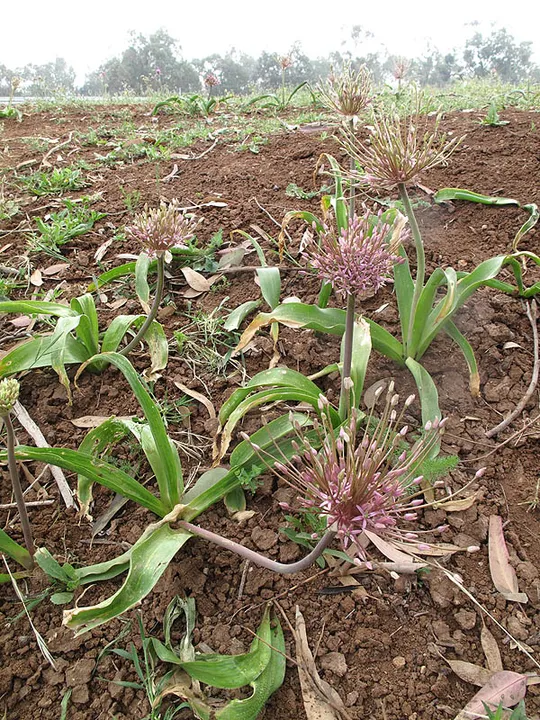Schubert's Garlic, Tumble Garlic
Allium schubertii



Allium schubertii is currently
found in 10 regions in the non-desert parts of Israel: the Upper Galilee, Lower
Galilee, low Hermon, southern Golan Heights, Hula Valley, Mount Gilboa, Jezreel
Valley, the Carmel, Pleshet, northern Negev and Samarian Desert. There are 75 documented sites from these
regions, but it disappeared from 15 other sites and in recent years it may have
disappeared from other sites as well. In the Upper Galilee A. schubertii is found on the Dalton Plateau, Mount Avivim, Meron, Jdeda and the
Kadesh Valley. In the Lower Galilee it grows on 27 sites scattered throughout
the region, with the exception of its western part. On the Low Hermon it is
found near the Nimrod Fortress. In the southern Golan Heights it is found on
several sites in the Nov -Afik region. In the Hula Valley it is found only near
Mahanayim. Along the Gilboa it is found at nine sites from the top of the ridge
to Merav. It survived in the Jezreel Valley near HaSargel Road, Tel Adashim,
Balfuria and the Tishbi Junction, but is extinct from the eastern valley, near
Kfar Yehezkel and Tel Yosef. In the Carmel it grows at Ramat HaNadiv and Keren
HaCarmel, and has disappeared from Haifa. There are populations in the region
of Kiryat Gat-Gal'On in Pleshet, close to its boundary with the Shfela and in
the northern Negev in Etan. In the Samarian Desert, on the Samarian boundary a
population was found in Rimonim. A. schubertii is
extinct in Israel in four regions: Ramot Menashe (Dalya), the Judean Mountains
(Jerusalem and Dahariya), Carmel Beach (Binyamina, Kvara) and the Shfela (between
Kfar Uria and Hulda).
Open habitats where
the inflorescence can tumble: fallow fields, traditionally managed agricultural
fields, areas of herbaceous vegetation and transition zone montane open forests;
generally on heavy alluvial soils in valleys and plains.
Allium
schubertii and a few other species from
Central Asia, Iran and the Caucasus were previously placed in a special section
in the genus Allium – Sect. Kaloprasum (which means
"beautiful garlic" or "beautiful leek") (Coleman, 1985). Recent
molecular research (Fritsch et al, 2010) shows that the species in this section
are not unique, but are included in the sub-genus Melanocrommyum to
which other species in Israel belong, among them – A. basalticum and A. aschersonianum. This analysis
indicated that A.
schubertii is particularly close to A. aschersonianum and A. basalticum (sensu stricto, see the
discussion under A.asclepiadeum),
three species that have pinkish-purple flowers.
A.
schubertii was
cultured and is grown in Europe as a cut flower and a garden
plant.
·
The numbers of
regions and sites on which Allium schubertii grows is
relatively large, but there is an evident declining trend in the number of
regions compared to the past. Moreover, in regions where the plant continues to
grow there are sites from which it has become extinct.
·
A. schubertii appears mostly in small populations, containing few plants, which
raises concerns regarding local extinctions.
·
Its inflorescence
is very impressive and it is threatened by picking.
·
The threat to
the typical habitat of A. schubertii – traditionally cultivated fields,
heavy soils and fallow fields – is growing due to the decrease of traditional
agriculture and expanding development activities that come at the expense of
these habitats.
·
Some of the
sites are found in nature reserves: in the southern Golan Heights, in the Mount
Meron Reserve, in the Mount Ahim and Mount Levanim reserves in the Lower
Galilee and in the Gilboa and Balfuria reserves (Jezreel Valley).
·
A. schubertii grows in the eastern Mediterranean countries and does not appear in
their red species lists.
A selected Allium
schubertii population should be monitored in each of the
regions in which it grows. Patches of fallow fields on heavy soils and
traditionally cultivated agricultural areas should be preserved and protected from
modern development.
Allium schubertii is an Eastern Mediterranean plant that grows in Israel, Jordan, Syria and Lebanon, southern Turkey and Libya.
Allium schubertii is a geophyte
with an impressive and attractive inflorescence that grows on in heavy soil fallow
fields and traditionally cultivated agricultural areas. The number of regions
and sites is declining due to its habitat vulnerability. Israel is on the
southern fringes of the geographic range of A. schubertii.
קולמן, פ. 1985. הסוג שום בישראל. רתם 12: 15, 89.
Fritsch, R.M., Blatner, F.R. & Guruschidze, M. 2010. New Classification of Allium L. subgen. Melanocrommyum (Webb. & Berthel.) Rouy (Alliaceae) Based on Molecular and Morphological Characters. Phyton 29: 145-320.
Current Occupancy Map
| 1000 squre meter pixel | 5000 squre meter pixel | 10000 squre meter pixel | |
|---|---|---|---|
| number of observations | 0 | 0 | 0 |
| in total pixels | 0 | 0 | 0 |
| Family | Liliaceae |
| Classification | On the endangered species list |
| Ecosystem | Semi-Steppe Belt |
| Chorotype | Irano – Turanian ( Eastern Mediterranean) |
| Conservation Site | Mount Shaul in the Gilboa |
| Rarity |
1
1
6
|
|---|---|
| Vulnerability |
0
2
4
|
| Attractiveness |
0
2
4
|
| Endemism |
0
0
4
|
| Red number |
1
3.2
10
|
| Peripherality | N |
| IUCN category | DD EW EX LC CR EN VU NT |
| Threat Definition according to the red book | Vulnerable |
 Based on:
Based on:






